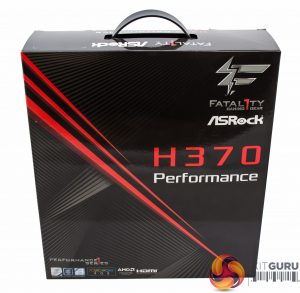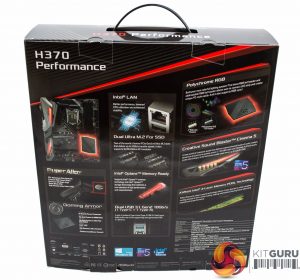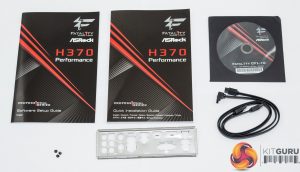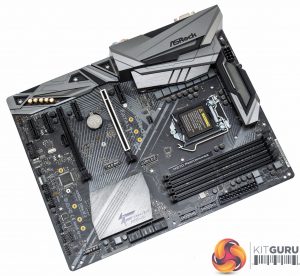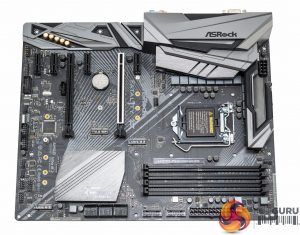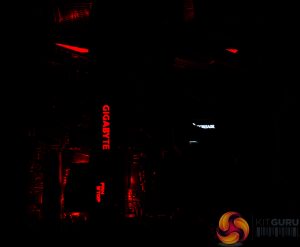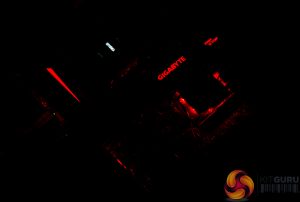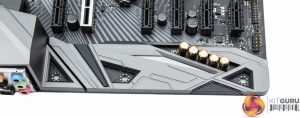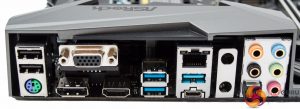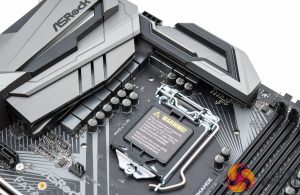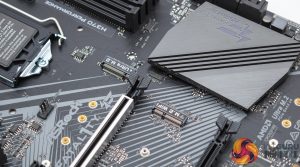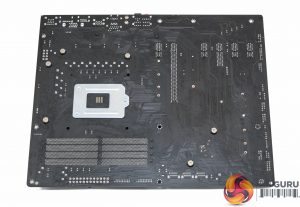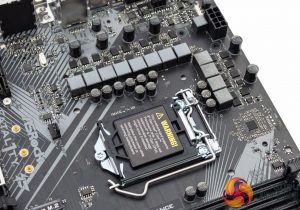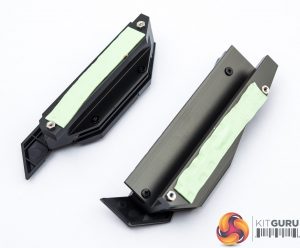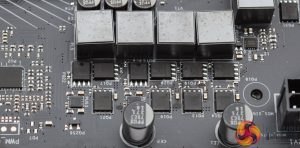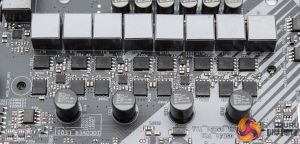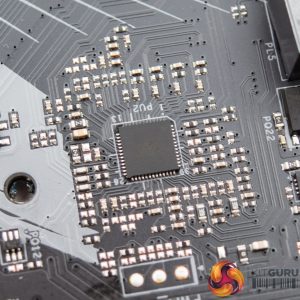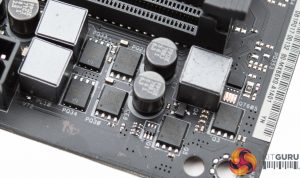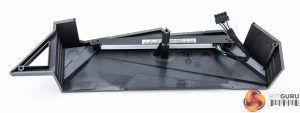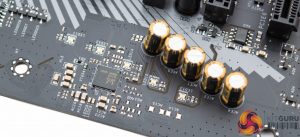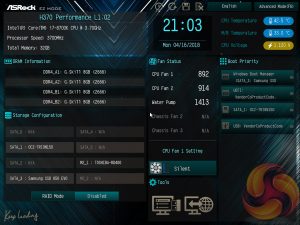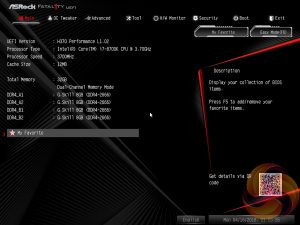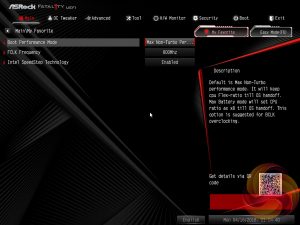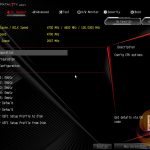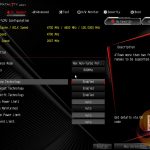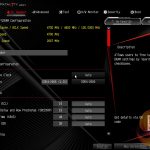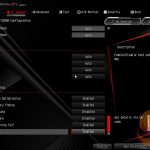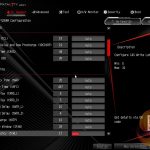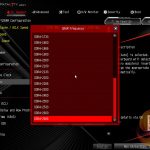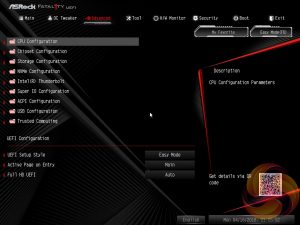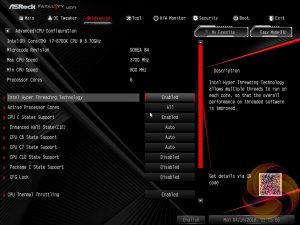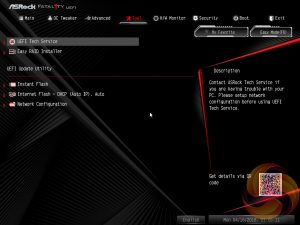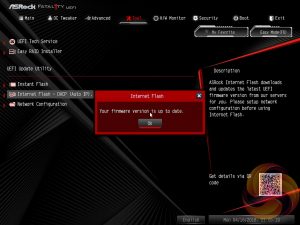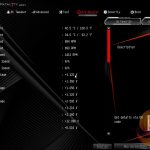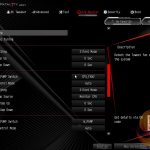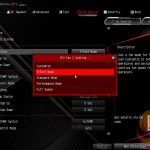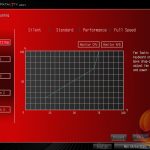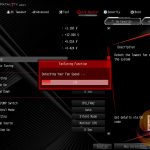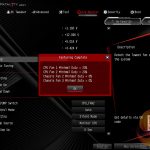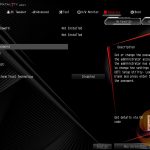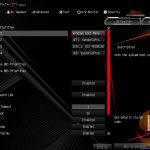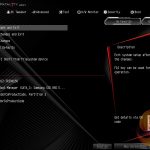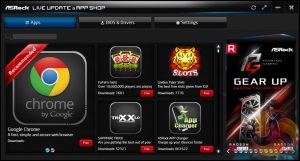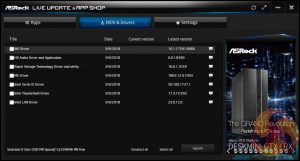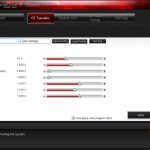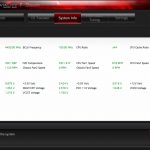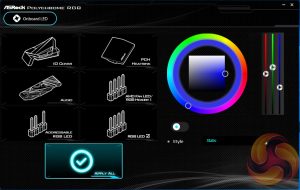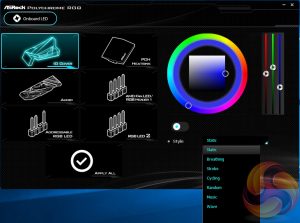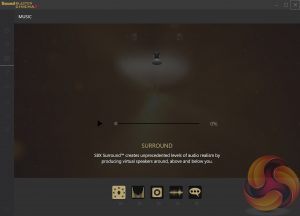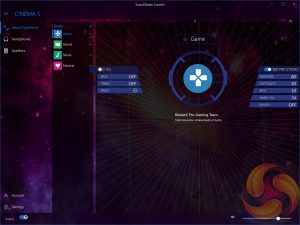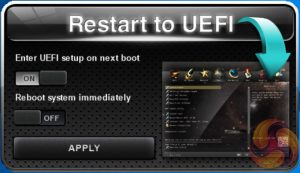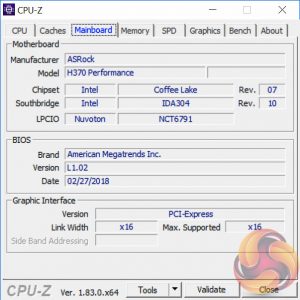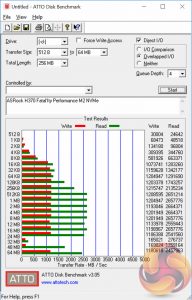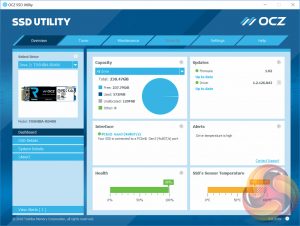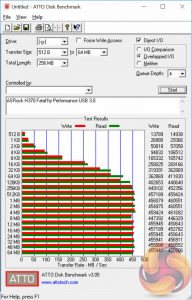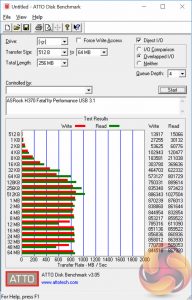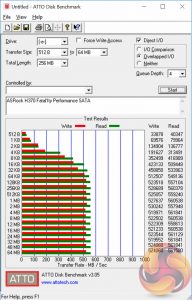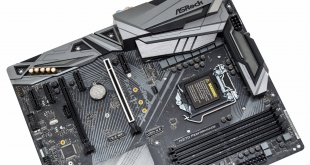
Intel's new H370 chipset targets a more mainstream segment than Z370 sacrificing CPU overclocking ability, among other things, in return for a lower price. Motherboard vendors are therefore able to bring to market gaming-oriented products, like this ASRock Fatal1ty H370 Performance, with lower price points than Z370 equivalents.
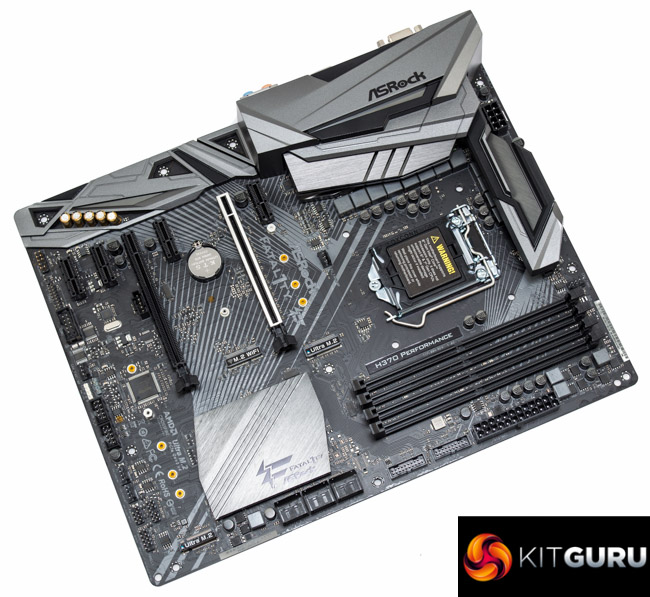
ASRock's take on Intel's H370 chipset is influenced by the fact that prospective buyers will be on a strict budget. Despite price-constraints, this is intended to be the most premium ASRock motherboard for Intel H370 and as such it includes some higher-end features and on-board hardware.
Product highlights include the dual M.2 storage slots operating at PCIe 3.0 X4 (32Gbps), multiple-zone on-board RGB lighting with an impressive three optional RGB headers, USB 3.1 10Gbps, Realtek ALC1220-based audio with a headphone amplifier and a 10-phase VRM for the CPU.
Certainly no slouch then and for the same money the nearest Z370 motherboard is no match in terms of feature richness. Yet there are limitations from the H370 chipset for prospective buyers to be aware of including no CPU overclocking, a maximum memory frequency of 2,666MHz and fewer PCIe lanes for multiple graphics card configurations.
Can the ASRock Fatal1ty H370 Performance remain an attractive option despite the chipset limitations? Let's find out.
| ASRock Fatal1ty H370 Performance | |
| Form Factor | ATX, 30.5cm x 24.4cm |
| CPU Socket | Intel LGA 1151 Version 2 |
| Chipset | Intel H370 |
| Memory | DDR4, 4 DIMMs, up to 64GB, up to 2,666MHz |
| On-board Graphics | Intel HD Graphics (supported CPUs) |
| Discrete Graphics | Single Nvidia graphics card configurations, up to AMD 2-way CrossFireX or Quad CrossFire |
| Expansion Slots | 1 x PCIe 3.0 x16 (x16 electrical, from CPU) 1 x PCIe 3.0 x16 (x4 electrical, from chipset)* 4 x PCIe 3.0 x 1 (from chipset)** *Becomes X2 if PCIe5 and PCIe6 (x1 slots) are occupied **PCIe3 is disabled if M2_3 WiFi slot is occupied by PCIe device |
| Storage | 6 x SATA III 6Gbps 2 x M2 (both support SATA III 6Gbps or PCIe x4 32Gbps)* *either M2_1 SATA or SATA_2 either M2_2 SATA or SATA_1 either M2_2 PCIe or SATA_0 |
| USB | 2 x USB 3.1 (2 Rear, Type-A and C, all via H370) 6 x USB 3.0 (2 Rear, 4 Front, all via H370) 6 x USB 2.0 (2 Rear, 4 Front, all via H370) |
| Networking | Optional M2_3 (M.2 WiFi) slot available Intel I219V Gigabit Ethernet |
| Audio | Realtek ALC1220 7.1 Channel HD Audio with headphone amplifier |
| Fan Headers | 5, all support 3/4 pin fans (1 x CPU @ 1A, 1 x CPU/W_PUMP @ 2 A, 3 x CHA/W_PUMP @ 2A) |
| Rear I/O | 2 x Antenna Ports 1 x PS/2 Mouse/Keyboard Port 1 x D-Sub (VGA) Port 1 x HDMI Port 1 x DisplayPort 1.2 1 x Optical SPDIF Out Port 2 x USB 2.0 Ports (Supports ESD Protection) 1 x USB 3.1 Gen2 Type-A Port (Supports ESD Protection) 1 x USB 3.1 Gen2 Type-C Port (Supports ESD Protection) 2 x USB 3.0 Ports (Supports ESD Protection) 1 x RJ-45 LAN Port with LED HD Audio Jacks: Rear Speaker / Central / Bass / Line in / Front Speaker / Microphone (Gold Audio Jacks) |
| UEFI | UEFI AMI 128Mb |
The packaging is neat with a convenient carry handle and styling that emphasises the Fatal1ty Gaming brand. The rear of the box highlights features like dual M.2, USB 3.1, Intel LAN and RGB lighting.
The accessory bundle is limited with just three M.2 screws for each of the M.2 slots, two SATA cables, a couple of documentation guides (with a case badge sticker and Fatal1ty-branded postcard hidden inside) and the driver & utility DVD. The low-quality of the rear I/O shield is something that stands out against most gaming motherboards of this ilk that are at least colour coded and padded or reinforced.
ASRock's Fatal1ty H370 Performance uses a neutral colour palette of grey and black and sharp angular details to the heatsinks and shrouds. It was only as recent as the Fatal1ty motherboards of the Z270 generation that ASRock was still using a black and red colour scheme.
ASRock complements the neutral colour scheme with the generous application of RGB lighting configurable using the ASRock Polychrome RGB software. There are three primary zones of on-board lighting – the rear I/O cover, chipset heatsink and audio PCB area. An additional three RGB headers are provided to add compatible strips.
SATA storage connectivity is the default six 6Gbps ports provided by the H370 chipset, USB 3.0 (USB 3.1 Gen 1) has two headers for up to four ports and USB 2.0 has two headers, also for up to four ports.
ASRock clusters three fan headers at the base of the motherboard along with two of the three RGB headers (one 12V G R B and one addressable). The second M.2 slot is located at the bottom of the motherboard and this slot supports up to 110mm drives, the longest M.2 form factor currently available.
The audio area has a unique plastic shroud covering it with the capacitors peeking through a gap, an innovative look that is typical of ASRock designs.
The rear I/O is well balanced in terms of audio, display and USB. ASRock also leaves in a blank mounting area for optional M.2 WiFi antennae.
- 2 x Antenna Ports
- 1 x PS/2 Mouse/Keyboard Port
- 1 x D-Sub (VGA) Port
- 1 x HDMI Port
- 1 x DisplayPort 1.2
- 1 x Optical SPDIF Out Port
- 2 x USB 2.0 Ports (Supports ESD Protection)
- 1 x USB 3.1 Gen2 Type-A Port (Supports ESD Protection)
- 1 x USB 3.1 Gen2 Type-C Port (Supports ESD Protection)
- 2 x USB 3.0 Ports (Supports ESD Protection)
- 1 x RJ-45 LAN Port with LED
- HD Audio Jacks: Rear Speaker / Central / Bass / Line in / Front Speaker / Microphone (Gold Audio Jacks)
The CPU has chunky looking heatsinks though looks can be deceiving as a significant part of these is a plastic shroud, which is screwed onto the aluminium heatsink blocks.
Around the CPU socket are a couple of fan headers and the third and final RGB header (12V G R B).
M.2 slot number one, which supports up to 80mm M.2 devices, is located next to the first PCIe lane while the optional M.2 slot for WiFi modules is sandwiched between the two full-size PCIe slots. If an optional PCIe module were to be installed a specific type would be required – an M.2 2230 WiFi card with Antennae on an extension cable that can be mounted in the rear I/O slot provided, similar to this example here.
Alternatively, the antenna cables (Mini PCI to RP-SMA male) and WiFi antennae (RP-SMA female) could be purchased separately keeping in mind a need for the cable to be of sufficient length to route to the rear I/O from this location. It is not made clear by ASRock if it will directly retail an optional WiFi module for users seeking to integrate WiFi into their motherboard.
Neither M.2 slot on this motherboard is cooled meaning most high-performance NVMe drives may throttle under heavy and sustained load.
The underside of the motherboard PCB is plain black and uses cross-head screws all over for easy disassembly, maintenance and repair.
With the heatsinks removed the CPU power delivery system is completely visible. As mentioned those CPU VRM heatsinks, which use thermal pads to make contact with the VRMs, include plastic pieces separately screwed on for styling purposes. This gives the impression they are larger than they actually are, though they are still more than sufficient to deal with the heat output of a stock Intel Coffee Lake CPU keeping in mind H370 does not support overclocking.
The CPU VRM includes 12 premium 50-amp chokes/inductors (Two Magic R50 and Ten Trio R36) along with fourteen NIKOS PK618BA and twelve PZ0903BK MOSFETs on the high- and low-side. There are four dual-channel UPI uP1961s MOSFET drivers and two single-channel uP1962s MOSFET drivers to control up to 10 phases.
In the segment of eight inductors the far right two phases, nearest the first PCIe lane, are separately controlled by two Richtek RT8120B single-phase PWM controllers.
The capacitors are 12K (12,000 hours) rated “black caps” from Nichicon's FP series, hence the marking “FP12K”.
The CPU PWM controller is also a UPI unit and is marked uP9521p, but there is no information about this controller on the UPI website so it must be a new unit. ASRock claims a 10-phase power design for this motherboard and given the MOSFET drivers used it does seem to be an 8+2 virtual phase solution. That is 4+2 true phases controlled by the PWM controller with the four phases doubled to eight by the uP1961s doublers.
Combining the 8+2 phase solution controlled by the uP9521p and the two additional phases controlled by dual Richtek RT8120B controllers, the total solution is 8+2+1+1 likely in the format vCore, iGPU, VCCSA and VCCIO.
The memory VRM contains a number of NIKOS and sinopower MOSFETs, inductors similar to the CPU power delivery and is linked a Richtek RT8120B controller.
Underneath the rear I/O shroud is a separate PCB which mounts the LEDs and these connect into the motherboard through a 4 pin connection.
Underneath the shroud for the audio section there is a Realtek ALC1220 codec along with an NE5532 Texas Instruments headphone amplifier, the capacitors are Nichicon Fine Gold (FG) Series specifically for audio equipment and are rated for up to 85 degrees Celsius.
Like all motherboard vendors the ASRock UEFI offers an “EZ MODE” option intended to provide a quick summary of commonly accessed UEFI options like the boot order and fan speeds as well as system monitoring information. This splash screen, for some reason, is not Fata1lty-skinned like the rest of the UEFI environment.
Pressing F6 takes you into the Advanced mode which starts with the Main page that overviews the UEFI version, installed processor and DRAM information. The My Favorite tab contains all recently accessed UEFI settings.
If you are unable to display some of the images on these pages, disable your ad blocker as it interferes with our gallery code.
OC Tweaker is the primary section of the UEFI environment for altering settings relating to the CPU, DRAM and Voltage. However, there is no overclocking on H370 so perhaps ASRock needs to drop the term “OC” from the title. Or perhaps the fact you could overclock a DDR4-2400 memory kit to DDR4-2666 is why it still keeps its OC title? A dubious linkage at best.
The Optimised Defaults, from pressing F9, will enable Intel's stock Turbo behaviour which is the best CPU performance that can be achieved on H370.
The remit of the advanced section is to give users the “everything else” of compatibility and functional UEFI options for on-board hardware that aren’t found in OC Tweaker. An inclusion at the bottom of the Advanced section is the ability to toggle the UEFI into a full HD mode which is disabled by default, at least it was on our test system monitor.
The Tool tab holds the Instant Flash utility which is beautifully simple; attach a USB device, pick the update file and update, or update automatically from the internet. ASRock has removed the in-UEFI RGB controls for this motherboard from the tools section so all controls are done in the software environment, which we'll cover later.
If you are unable to display some of the images on these pages, disable your ad blocker as it interferes with our gallery code.
The Monitor section includes a number of voltage, temperature and fan speed read-outs as well as all the CPU and System fan controls. Further fan tuning can be done by first running the “Fan Tuning” wizard to calculate the full fan speed range of each attached fan (minimum and maximum speeds in RPM). Then from within the FAN-Tastic tuning window customised profiles can be set using the fan speed graph and the mouse to drag-and-drop the graph's line.
Security, Boot and Exit tabs round off the rest of the ASRock UEFI environment. No summary of UEFI changes made in the session is presented to the user before they save and exit.
ASRock’s App Shop provides the dual role of serving out ASRock’s own software and approved third party software (some of dubious value), but also includes a MSI Live Update-style function which scans for certain BIOS and driver versions and informs the user when a newer version is available. It’s reasonably useful for both of its provided functions and isn’t too intrusive, but does pop up the occasional notification in Windows 10.
F-Stream, called A-Tuning on non-Fatal1ty products, is ASRock’s equivalent to ASUS AI Suite, Gigabyte EasyTune and MSI Command Centre, allowing you to change UEFI settings on-the-fly and tune the fan speeds with the ASRock FAN-Tastic tuning functionality. It’s a reasonably well polished piece of software, is light on system resources and not very intrusive.
ASRock Polychrome RGB seems to be a rebranding of the previous ASRock AURA RGB, perhaps due to naming similarities with the ASUS AURA RGB solution. The new software is a little bit slicker with handy visualisations of each of the available zones that can be altered. The way the colours and modes are changed is the same as predecessor software. It works by selecting the colour on the outer ring first, then the inner square after and then you can pick the style from the drop down menu, there are currently 7 modes as shown above.
The software felt “laggy” with each click taking a second or so to respond, the LEDs also flash back to the default red briefly in between each colour or mode change. There is clearly some software optimisation still left to be completed by ASRock's software development team.
At some point in the future we expect ASRock may integrate RGB into its graphics card though at the moment there are still a range of other computer hardware products that are compatible with ASRock's Polychrome RGB Sync, as listed on ASRock's microsite.
Rather than invest valuable time and resources into developing its own audio enhancement application, ASRock makes use of the fairly slick Creative Sound Blaster application which has two parts – Sound Blaster Connect and Sound Blaster Cinema.
Restart to UEFI does what it says on the tin and is handy if you're not quite quick enough on the F2 or Delete keys.
We will be outlining the ASRock Fatal1ty H370 Performance motherboard's performance with the Intel Core i7 8700K CPU, 32GB* of 2,666MHz** G.Skill Trident Z DDR4 memory and a Gigabyte GTX 1080 G1 Gaming.
*16GB for mini-ITX motherboards.
**3,200MHz for Z370, H370 is limited to 2,666MHz.
H370/Z370 Motherboard Test System:
- Processor: Intel Core i7 8700K (Default Intel Turbo Behaviour – 6C @ 4.3GHz, 4-5C @ 4.4GHz, 3C @ 4.5GHz, 2C @ 4.6GHz & 1C @ 4.7GHz).
- Memory: 32GB (4x8GB*) G.Skill Trident Z XMP (3,200MHz** 16-18-18-38 @ 1.35V), *2x8GB for mini-ITX motherboards **2,666MHz on H370 Motherboards.
- Graphics Card: Gigabyte GeForce GTX 1080 G1 Gaming.
- System Drive: Samsung 850 EVO 500GB SSD
- CPU Cooler: Corsair H100i V2 with Two ML120 Pro Fans.
- Power Supply: Seasonic Platinum 760W SS-760XP.
- Operating System: Windows 10 Pro 64-bit
Comparison H370/Z370 Motherboards:
- ASRock Fatal1ty H370 Performance
- ASUS ROG Maximus X Formula (Z370)
- ASUS ROG Strix H370-F Gaming
- Gigabyte Z370N WiFi
Drivers and UEFI:
- Intel Chipset 10.1.1.44 (Z370) and Intel 10.1.16.3 (H370)
- Intel ME 1805.12.0.1097 (H370) and 11.7.0.1045 (Z370)
- Nvidia GeForce 390.77 VGA drivers.
- ASRock UEFI Version L1.02 (27/02/2018)
Tests:
- Cinebench R15 – All-core CPU benchmark (CPU)
- SiSoft Sandra 2017– Processor Arithmetic Test (CPU) and Memory Bandwidth Test (Memory)
- 7-Zip 18.01 x64 – Built-in 7-Zip benchmark test (CPU)
- AIDA64 Engineer 5.95 – System cache & memory benchmark and stress test (Memory and Power Consumption)
- 3DMark v2.4.4264 – Time Spy (1440p) test (Gaming)
- Ashes of the Singularity: Escalation – Built-in benchmark tool CPU-Focused test, 1920 x 1080, Extreme quality preset, DX12 mode (Gaming)
- Deus Ex: Mankind Divided – Built-in benchmark tool, 1920 x 1080, Ultra quality preset, DX12 mode (Gaming)
- ATTO 3.05 – M.2, USB 3.0, USB 3.1, and SATA 6Gbps transfer rates (Motherboard)
- Rightmark Audio Analyzer 6.4.1 – Record and playback test using a line-in to line-out loopback with a 3.5mm audio cable (Motherboard)
7-Zip
7-Zip is an open source Windows utility for manipulating archives. We measure the Total Rating performance using the built-in benchmark tool. The test stresses all CPU cores to 100% and shows an affinity for memory bandwidth.
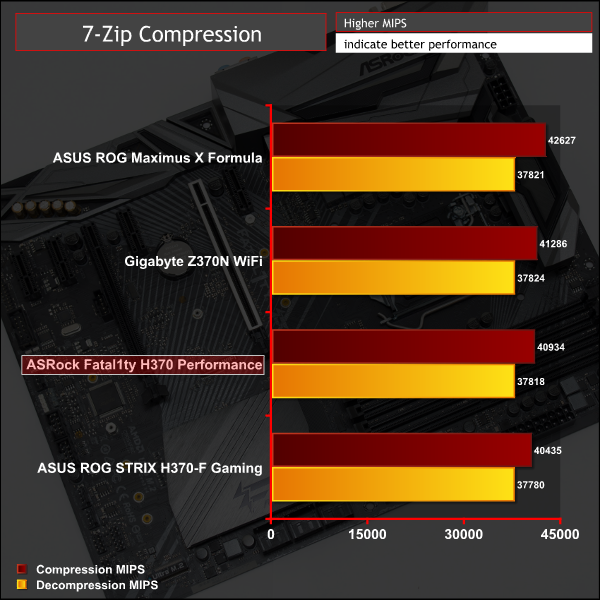
Cinebench R15
Cinebench is an application which renders a photorealistic 3D scene to benchmark a computer’s rendering performance, on one CPU core, all CPU cores or using the GPU. We run the test using the all core CPU mode.
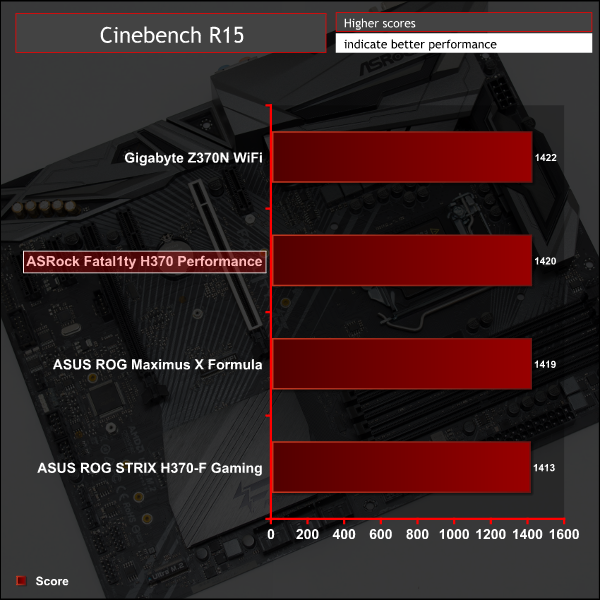
Sandra Processor Arithmetic
SiSoft Sandra 2017 is a multi-function utility program that supports remote analysis, benchmarking and diagnostic features for PCs, servers, mobile devices and networks. We run the application’s processor arithmetic test to gauge the CPU performance on each tested motherboard.
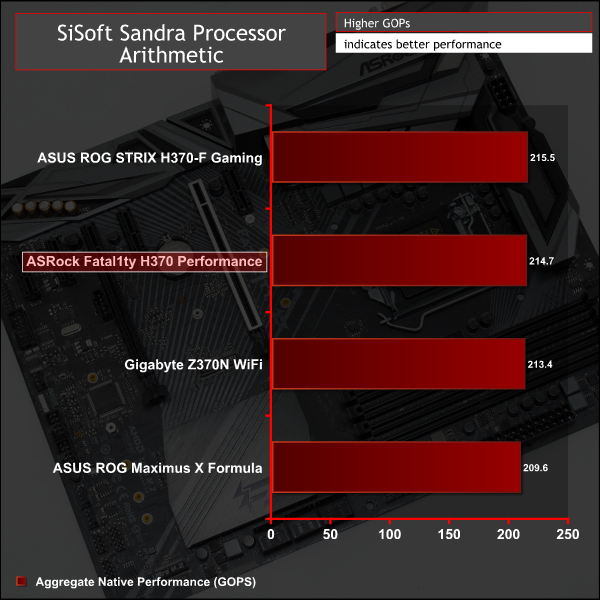
CPU performance is similar to Z370 when running with stock Intel Turbo behaviour.
AIDA64 Engineer
AIDA64 Engineer is a multi-featured software suite for diagnostics, stress testing, benchmarking, software auditing and various other measurement parameters. We use AIDA64 Engineer to benchmark memory throughput and latency.
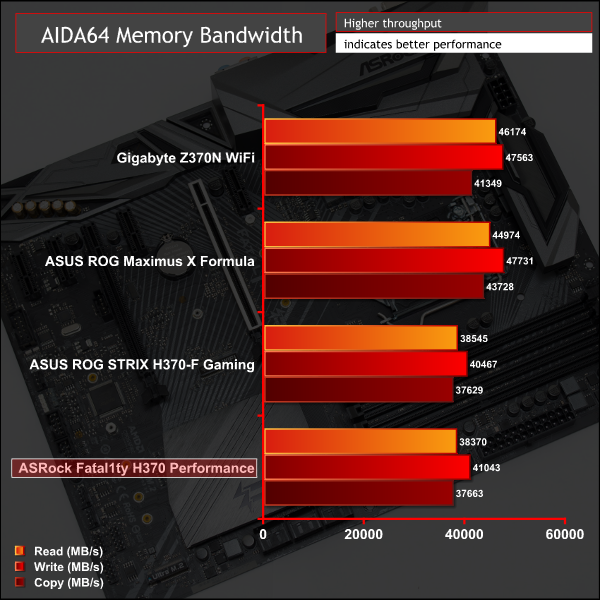
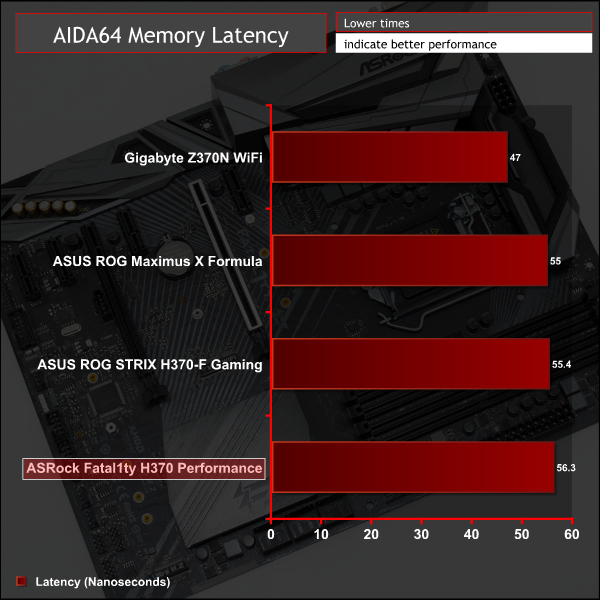
Sandra Memory Bandwidth
SiSoft Sandra 2017 is a multi-function utility program that supports remote analysis, benchmarking and diagnostic features for PCs, servers, mobile devices and networks. We use the SiSoft Sandra memory bandwidth test to provide a set of memory bandwidth results.
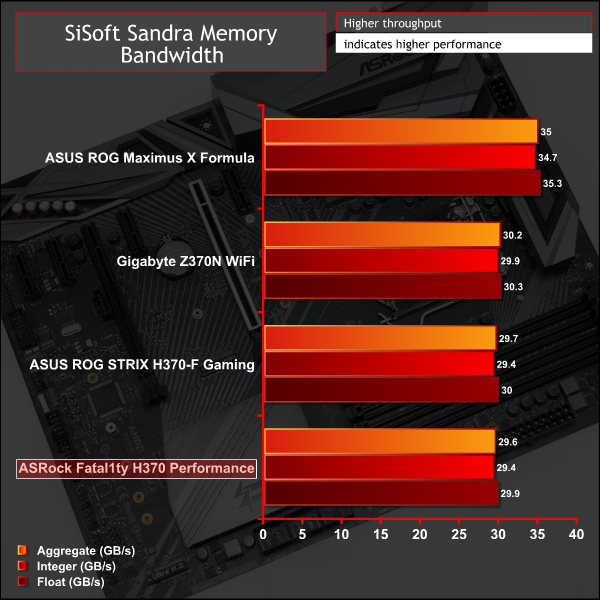
Memory performance takes a hit compared to Z370 motherboards we previously tested, since the 3,200MHz memory is now limited to 2,666MHz. However, if Z370 using 2,666MHz were to be compared to H370 using 2,666MHz, we expect that performance would be near-identical.
However, it should also be noted that overclocking the CPU can also enhance memory performance at the same memory frequency so Z370 definitely has the memory performance advantage. There is very little to separate the ASUS and ASRock H370 motherboards.
3DMark
3DMark is a multi-platform hardware benchmark designed to test varying resolutions and detail levels of 3D gaming performance. We run the Windows platform test and in particular the Time Spy benchmark, which is indicative of high-end 1440p PC Gaming.
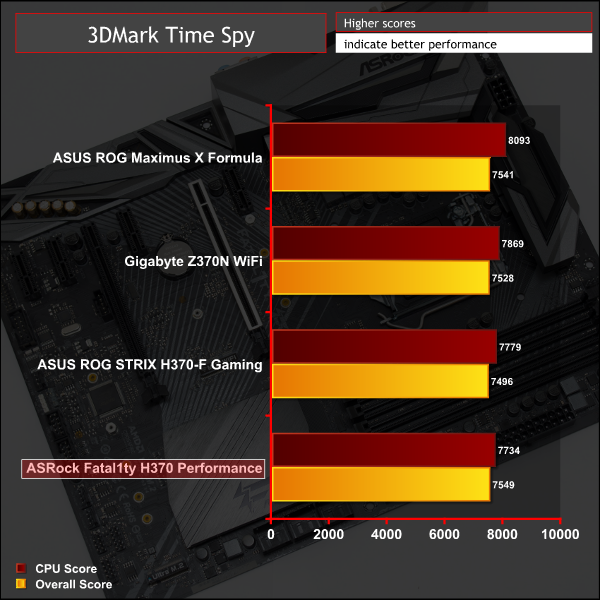
Ashes of the Singularity: Escalation
Ashes of the Singularity: Escalation is a Sci-Fi real-time strategy game built for the PC platform. The game includes a built-in benchmark tool and was one of the first available DirectX 12 benchmarks. We run the CPU-focused benchmark using DirectX 12, a 1080p resolution and the Extreme quality preset.
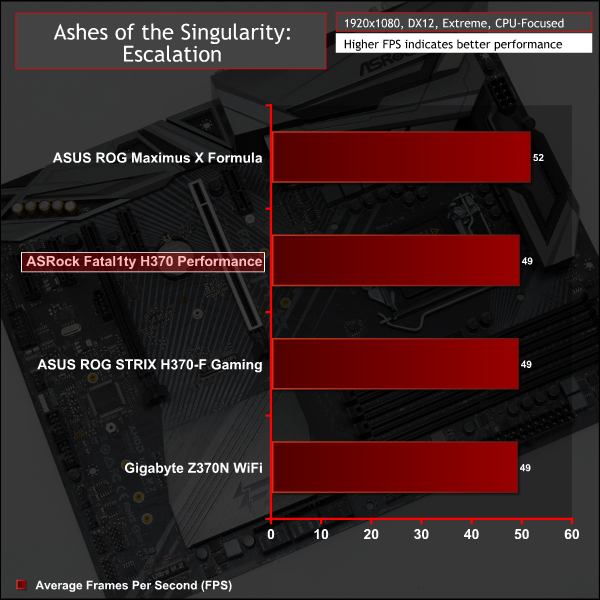
Deus Ex: Mankind Divided
Deus Ex: Mankind Divided is an action role-playing stealth video game released in August 2016. A built-in benchmark utility is included and we test using the Ultra quality preset and the DirectX 12 API at a 1080p resolution.
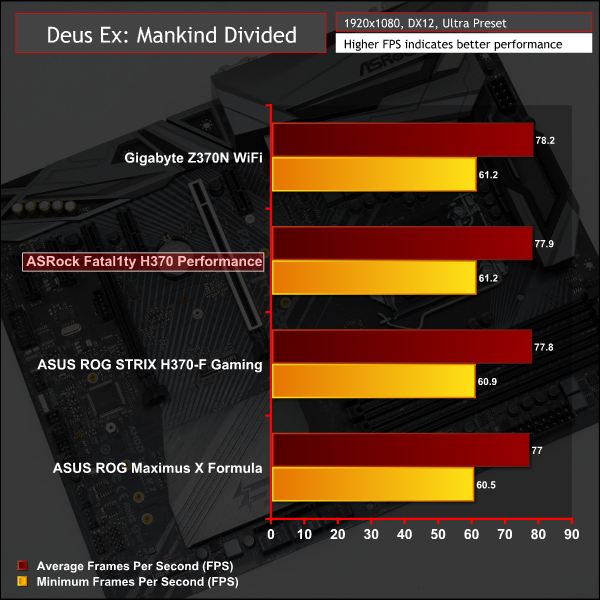
Gaming performance is more or less the same as Z370 in our testing since slower memory makes limited difference to frame rates – 2,666MHz memory already offers ample bandwidth for most modern games.
ATTO Disk Benchmark
The ATTO disk benchmark is a Windows-based utility for testing storage performance of any storage drive or controller. We use the default benchmark setup.
M.2 PCIe Performance
For M.2 testing we use a Toshiba OCZ RD400 256GB M.2 PCIe NVMe SSD.
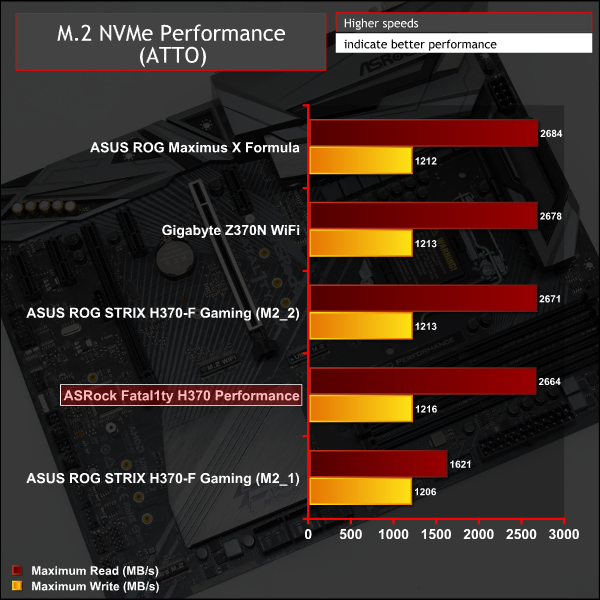
M.2 performance is absolutely fine and the drive tested is able to operate at full speed in both M.2 slots. However, no M.2 cooling is provided so the drive does throttle within a relatively short time period. The lack of M.2 cooling is a little disappointing but understandable given the price constraints of this motherboard.
USB Performance
We test USB 3.0 and 3.1 performance using a pair of Transcend SSD370S 512GB SSDs in RAID 0 connected to an Icy Box RD2253-U31 2-bay USB 3.1 enclosure powered by an ASMedia ASM1352R controller.
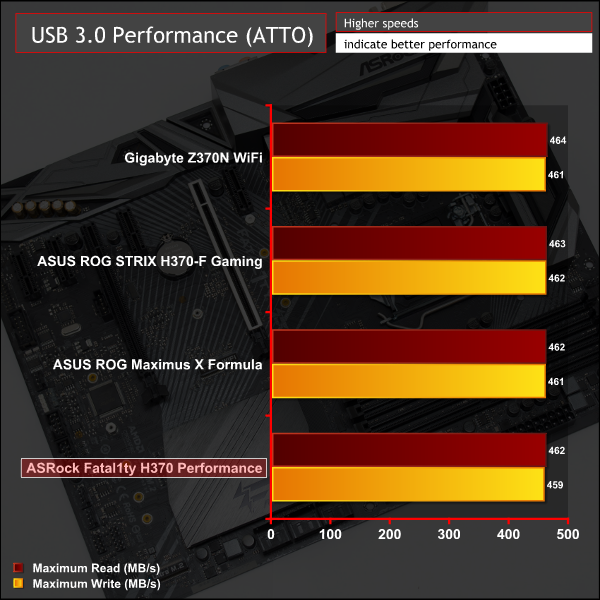
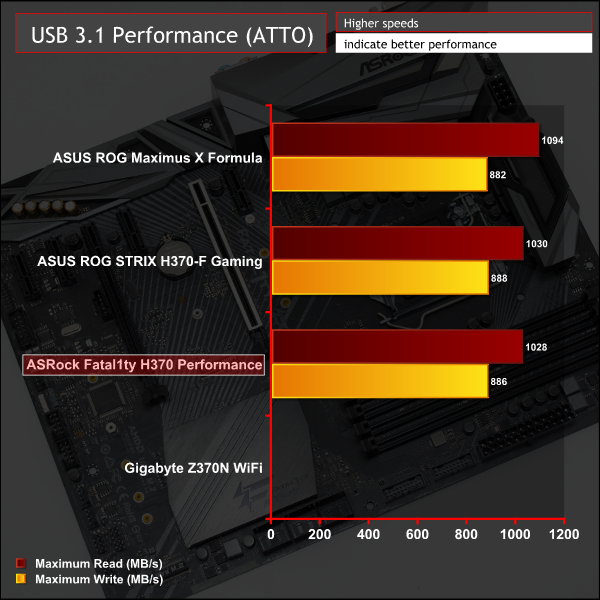
USB 3.1 and 3.0 performance are roughly the same as Z370. H370, unlike Z370, includes USB 3.1 (Gen 2) by default whereas on Z370 it is an optional extra that motherboard vendors are required to add themselves.
SATA 6Gbps Performance
For SATA 6Gbps testing we use an OCZ Trion 150 480GB SSD.
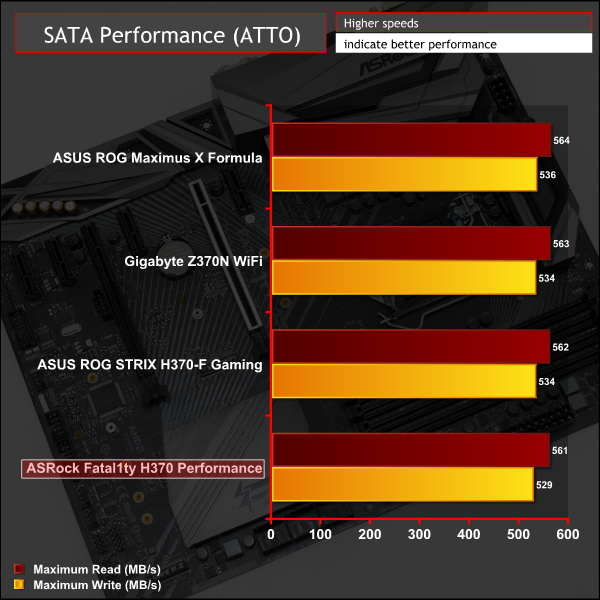
SATA III performance is typical and directly comparable to Z370.
Audio
Rightmark Audio Analyser is a freeware benchmarking utility designed to objectively test the performance characteristics of audio solutions. We setup a line-in line-out loop and execute the record/playback test before generating the results report you see below. A sampling mode of 24-bit, 192 kHz is tested where available. If unavailable the closest alternative operating mode available is used and clearly marked.
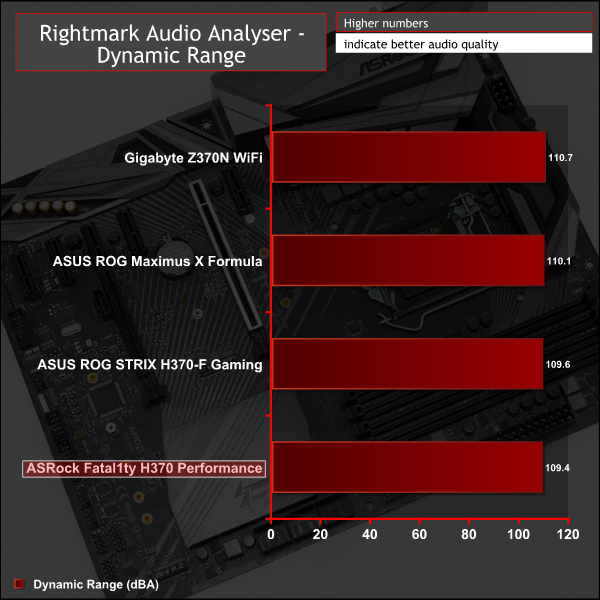
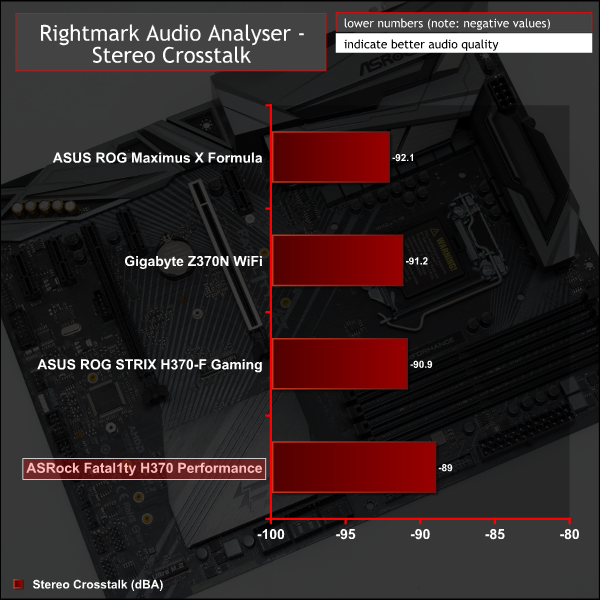
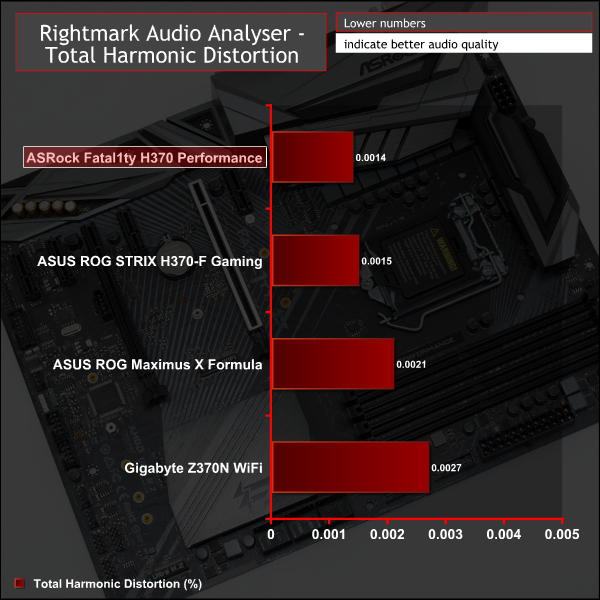
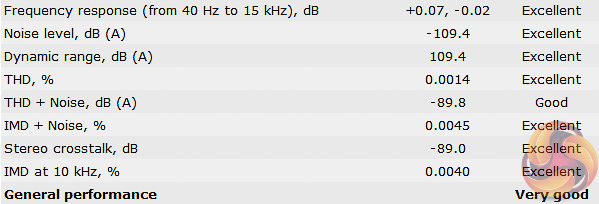
Audio performance on the ASRock Fatal1ty H370 Performance was very good and equals most Z370 motherboards we've tested since it uses the same audio codec, headphone amplifier and audio capacitors.
Power
We leave the system to idle on the Windows 10 desktop for 5 minutes before taking a reading. For CPU load results we run AIDA64 CPU, FPU, Cache and Memory stress tests and take a reading after 5 minutes. The power consumption of our entire test system (at the wall) is shown in the chart.
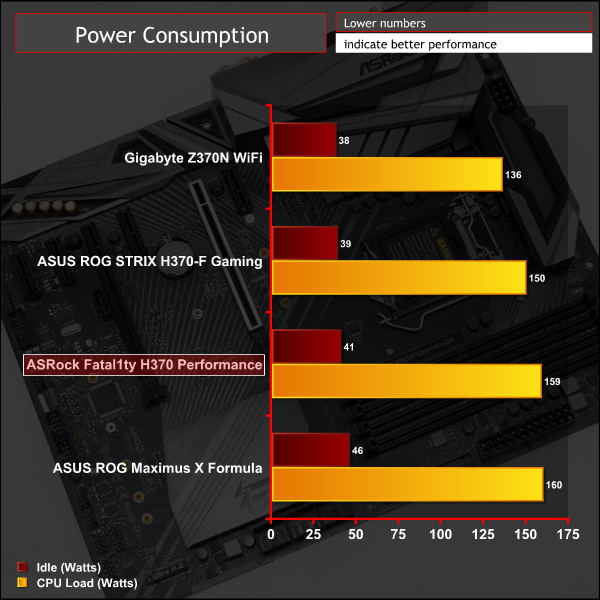
Power consumption is in line with non-overclocked Z370 motherboards, perhaps a little lower because of the slower memory, though this is easily offset by variations in the way each motherboard vendor applies vCore voltage.
The default ASRock vCore was too aggressive given there is no overclocking supported and the CPU is running within Intel specification. The voltage was anywhere between 1.24 and 1.28 volts under load which is higher than it needs to be. It may well be worth using the UEFI settings to reduce the core voltage down to 1.175-1.2 to save power and lower temperatures.
As highlighted in KitGuru's previous ASUS H370 review the target audience for Intel's new chipset is one which does not require overclocking, high-speed memory or multi-GPU configurations. Those things aside H370 is very similar to Z370 and offers a fairly high-end desktop experience.
The ASRock Fatal1ty H370 Performance targets that gaming audience that doesn't require overclocking and given the price, the quality and quantity of features on offer is fairly impressive. ASRock's on-board RGB lighting is plentiful and easy to configure with excellent expansion options. Both M.2 slots operate at full 32Gbps speed and there's a strong complement of USB and SATA provided by the H370 chipset. The CPU VRM is up to the job and the heatsinks are sufficient for a CPU that cannot be overclocked.
The audio implementation is of high quality with Realtek's latest-and-greatest codec as well as a headphone amplifier and Gold Series audio capacitors. Networking coverage is adequate with Intel Gigabit and an optional M.2 WiFi module, though we'd prefer ASRock bundle a module in with a separate WiFi SKU, or clearly communicate with customers how they can purchase a certified-compatible optional extra through its product page.
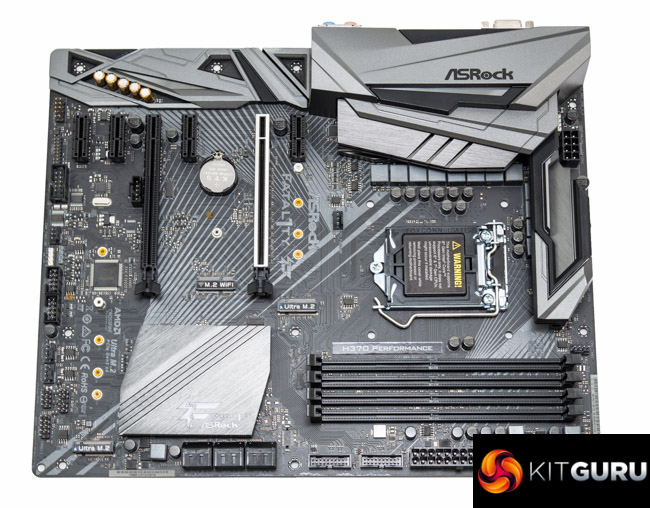
The ASRock H370 Fatal1ty motherboard does, however, have its drawbacks including a slightly over-zealous application of CPU vCore when using optimised default UEFI settings. The severity of this issue is trivial in that no long-term damage will arise, it's straight forward for the user to fix it with a negative vCore offset and ASRock could also change this themselves through a UEFI update.
Aside from the limitations that come with the H370 chipset, we also found the lack of M.2 cooling to be a hindrance since high performance NVMe drives will throttle under heavy load. The M.2 WiFi slot is also on the quirky side given it is quite far from the rear I/O antenna mount and it is tricky to find a compatible WiFi module with the right antenna and cable setup.
The ASRock Fatal1ty H370 Performance is a motherboard that balances a high-end feature set with a cost-conscious target market reasonably well and the areas which it falls down can quite reasonably be overlooked given the price.
The ASRock Fatal1ty H370 Performance has a retail price of £116.99 at Scan Computers UK and is sold with a 2 year warranty as standard.
Pros:
- Reasonable price
- Excellent RGB lighting functionality and expandability
- Smart and neutral aesthetics
- Dual M.2
- Capable CPU power delivery system
- High quality audio with headphone amplifier
Cons:
- vCore voltage on the high side
- No M.2 cooling
- H370 chipset limitations
- M.2 WiFi module may be difficult to effectively utilise
- Low quality I/O shield
KitGuru says: ASRock's Fatal1ty H370 Performance is a well-rounded and affordable gaming motherboard for a target audience not requiring overclocking or multiple graphics card configurations.
Be sure to check out our sponsors store EKWB here
 KitGuru KitGuru.net – Tech News | Hardware News | Hardware Reviews | IOS | Mobile | Gaming | Graphics Cards
KitGuru KitGuru.net – Tech News | Hardware News | Hardware Reviews | IOS | Mobile | Gaming | Graphics Cards


